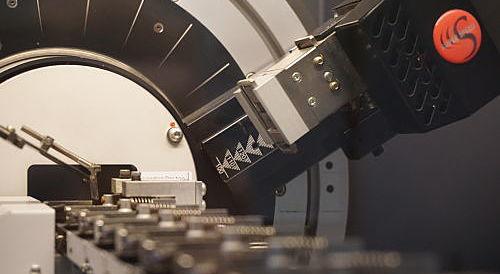ETC also hosts a number of X-ray techniques which provide qualitative and quantitative analysis of crystalline material characteristics and mechanical properties. X-ray diffraction (XRD) is a powerful analytical technique used in materials science, chemistry, physics, and geology to determine the structure and composition of crystalline materials. X-ray diffraction is a versatile and widely used technique with applications in many different fields.
Some of the applications of X-ray diffraction include:
- Material identification and characterization: X-ray diffraction can be used to identify and characterize the structure of materials, including minerals, metals, ceramics, and polymers. This information can be used to determine the composition, crystal structure, and crystallographic orientation of the material.
- Quality control and testing: X-ray diffraction can be used to verify the quality of materials during the manufacturing process, as well as to test the finished products to ensure that they meet the required specifications and standards.
- Phase analysis: X-ray diffraction can be used to determine the phase composition of a material, including the identification and quantification of individual phases present in a mixture.
- Crystallography: X-ray diffraction is a key tool for crystallography, which is the study of the arrangement of atoms in crystals. By analysing the diffraction pattern, crystallographers can determine the three-dimensional arrangement of atoms in a crystal structure.
- Structural analysis: X-ray diffraction can be used to determine the structure of complex materials. This information is important in drug discovery and the design of new materials.
Single Crystal X-ray Diffraction
Rigaku Oxford single crystal X-ray diffractometer for elucidating molecular and solid-state structures
Our single crystal X-ray diffractometer allows for complete structural characterisation by providing a complete three-dimensional structure showing molecular and solid-state identity, conformation and stereochemistry.
- Dual wavelength Cu/Ag high flux micro-focus X-ray source
- Atlas CCD detector
- Temperature range 80K - 500K
- Up to 20GPa applied pressure

X-Ray Diffraction
Identification and analysis of crystalline materials
Our X-Ray diffraction facilities include copper, molybdenum and chromium tubes. The equipment has two setting for routine phase identification and a ¼ cradle setting for residual stress, multi-layer and polar analyses.
- Copper for routine analyses
- Molybdenum for materials with small unit cells
- Chromium for residual stress analyses
X-ray Fluorescence
Rigaku NEX DE EDXRF for high resolution elemental detection
Trace elements can be detected using our Rigaku NEX DE EDXRF for analysis of samples in air or helium.
- Elemental and chemical analysis
- Detect at a parts per million level